How to take care of our batteries?
01. 12. 2003
Right care of the batteries and their use in airsoft belong between very underrated thing. Most people enjoy oneself, treats and keeps the weapon as such, but on a battery that is the true heart of the weapon is often forgotten ...
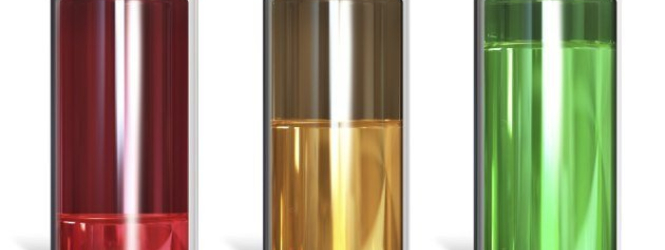
Before WE get to the practical things you need to absorb a bit boring (for some very interesting) theory.
Concepts
Nominal voltage - the voltage of a single cell. NiCd and NiMH voltage of 1.2V, unlike primary cells that have 1.5V.
Nominal capacity - the amount of electric charge in Ah declared by the manufacturer, which may deliver a separate article at 5 pm. In the final discharge voltage of 1.0 V at 20 ° C for charging, storing and discharging.
Reference test current - it is customary to give discharge and charge currents as multiples of the rated capacity C (Ah). Reference test current It (A), which better corresponds to the physical principles, is determined as the ratio of the rated capacity C (Ah) and the time interval of 1 hour..
The actual voltage - actual voltage battery element is dependent on many factors (especially charge state article and ambient temperature) and during charging and discharging is changing. The form of the dependence on standard articles for general use is well illustrated in the following figure.
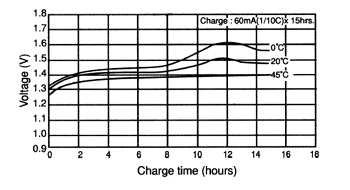 |
| The dependence of voltage on the charging state and ambient temperature with a small charging current - NiCd. |
From the figure are very well noticeable changes in the shape of the charging curve with increasing ambient temperature. Particularly, it should be noted that at high temperatures (about 45 ° C and higher) is a sharp increase in tension before the end of the charge has been negligible. Under such conditions has therefore not capable of stopping the charging methods based on the detection.
The following figure shows the dependence of the cell voltage depending on the charge state during discharging various currents after the previous charging current 0,1It for 15 h.
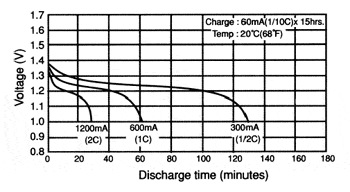 |
| Dependence of the voltage on the charging state at high discharge currents - NiCd. |
Actual capacity - the actual battery capacity is similar to the actual voltage depends on many factors, primarily on the size of the discharge current and ambient temperature, which is well illustrated in the following figures.
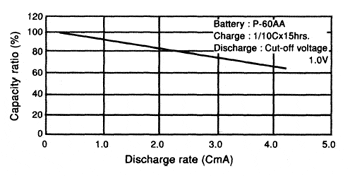 |
| The dependence of the actual capacity to the discharge current during discharging to the voltage of 1.0 V after the previous charging current 0,1It for 15 h. |
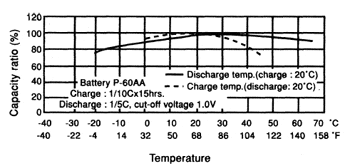 |
| The dependence of the capacity on the ambient temperature during charging and discharging. |
Optimum charging is achieved in the temperature range 10 ° C to 30 ° C. At ambient temperatures below 0 ° C because the article can not be necessary chemical reactions absorbing free gases, the pressure inside the cell gradually increases, which activates the safety valve. Then will they escape into the environment, leading to irreversible deterioration of the parameters of the article, especially its real capacity.
Internal impedance article - largely determines the performance and operating life. High impedance strangles the flow of energy from the battery to the powered device.
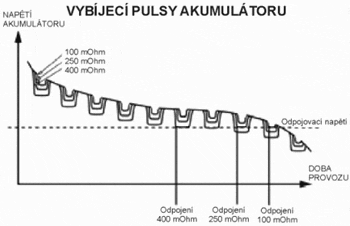 |
| Dependence of the battery voltage to the internal impedance. |
In the picture WE compare the voltage and the corresponding period of active battery low, sized and high impedance when connected to a digital load. Pulses of current pushes down the voltage, resulting in premature rejection of the battery to supply the required current though the battery still contains energy.
If the load after disconnecting the battery voltmeter to measure the voltage on contacts with normally "recovers" and the voltmeter displays the normal value. This phenomenon occurs mainly in nickel-based batteries. A battery with high impedance can operate without problems when loaded with sensitive loads.
Memory effect - it is usually incorrectly called property batteries, according to which if not completely discharge the battery should have the battery in the charging and discharging another cycle of smaller capacity, which should go to avoid dovybitím battery before starting the charge cycle. This feature, however, was never even theoretically, nor experimentally proven.
The term memory effect is yet to be marked characteristic of batteries, which can be explained by the following example. , Use a battery in such an application where it will normally be operated in a state of near full charge due to the short-term cyclical discharging and subsequent charging, i.e., so as to continuously move after the beginning of discharge curves back and forth.
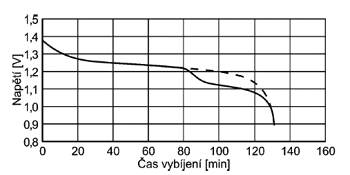 |
| Memory effect the accumulator cell. |
In the picture so that it corresponded to stretch the charging curve to, say, 40 minutes. In practice, such application might be, for example. Rechargeable batteries for operation of space satellites in Earth orbit, where in short intervals alternating night (discharge papers) and day (charging current from the solar panels).
If the battery is used in this way for some reasons, then WE discharged totally, WE can at the end of the discharge cycle observe a sharp drop in battery voltage (shown by the solid line) compared to the initial discharge curve (shown by dashed lines). Such a voltage drop, however, does not change the amount of charge that the battery will supply the load, ie the real capacity of the battery.
In normal operation, the battery is called. "Memory effect" occurs in practice. Most often this effect is confused resulting in overcharging (partly charging at high cell temperatures) which causes a decrease in capacity in a subsequent cycle, and reduces the battery life.
Self discharge - is a characteristic of the battery, resulting in actual storage gradual reduction charge which the battery during discharging able to deliver to a load. Charge decay rate (capacity reduction) is strongly dependent on the ambient temperature during storage. According to some data there for the first 24 hrs. In the loss of 10-15% of the battery capacity.
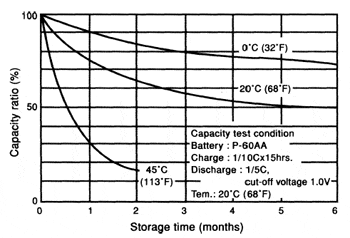 |
| The dependence of the capacity of NiCd battery storage time at different storage temperatures. |
Because NiCd batteries self-discharge when crystallization occurs in the electrolyte of individual cells and crystals are formed due to the relatively slow self-discharge during relatively large, the subsequent charging can not dissolve completely and the battery thus has several charge and discharge cycles smaller capacity. In extreme cases, when extremely large increase in crystal threatened mechanical separator puncture and subsequent shorting between electrodes. For this reason, it is recommended to store NiCd batteries are fully discharged.
NiMH batteries are usually stored in a charged state, it is recommended after every 6 months of storage batteries recharge charge corresponding to about 50% of the nominal capacity of the storage battery.
To reduce self-discharge, it is recommended to charge the battery before use.
The actual life - the battery depends greatly on the conditions under which they operate (ambient temperature, charge and discharge currents, etc.) Manufacturers say that the life of the standard battery operated under appropriate conditions should be greater than 500 cycles for NiMH and about 1,000 cycles for NiCd . Over the lifetime of the border is considered the loss of 20-30% of the battery capacity in comparison with a new battery.
Charging and discharging batteries
When charging NiCd batteries need to pay special attention to avoid repeated charging (battery charging even after reaching full charge), it leads to irreversible negative changes of parameters articles.
Before charging the battery, it is important that its temperature stabilized at room temperature. Charging the battery at temperatures below 15 ° C and above 30 ° C is reflected in the next cycle decrease in capacity. Stabilization of the temperature from 0 ° C to 15 ° C at room temperature for approximately 2 hours. It should be appreciated that it is necessary to stabilize the temperature inside the battery, not just on the surface. Charging the battery with temperatures below freezing causes the hydrogen leak through the safety valve battery and battery penetrates atmospheric oxygen, and this causes great self-discharging of the battery. This is reflected by the fact that while the battery after charging is at full capacity, but after a few days it is fully discharged.
New batteries or batteries after prolonged storage, reaching full capacity only after several charge and discharge. Accumulators in this case is recommended to charge a standard charge (14-16 hours at 0,1It).
Accumulators may not be in charge never under any circumstances polarity. Their polarity results in a massive release of internal heat and gases, which eventually may lead to the activation of the safety valve and the consequent devaluation of the article, in extreme cases even to mechanical deformation or rupture.
Batteries should never and under no circumstances discharge discharged completely, since this condition can lead to their destruction. If you have several batteries in one kit, follow the final discharge voltage of 1V per cell. Doing so may turn polarity of one cell, and thus leak in it, followed by the permanent capacity reduction kits. This occurs most often in mobile phones (phone switches itself off and
WE still want to send another SMS). How many times has it happened to stop to shoot a gun, but after 10 minutes you've got a couple of shots?
When connecting battery cells in the battery, it is necessary to bear in mind that due to the non-zero internal resistance cells and unlike the real capacities of the individual cells during discharge can cause spontaneous polarity of one or more battery cells. With this particular encounter when domestic production of batteries or their "Repas".
It is important to bear in mind that if you use the battery for example. 12V (composed of 10 separate articles) and the voltage drops to 1V per cell, has a total battery voltage of 10V yet. At this voltage can usually still use the battery, but
WE run the risk that its polarity and thus destruction.
Charging modes
To charge the battery seems to consider several different charging modes allow fast battery charging at intervals of tens of hours to a few tens of minutes. Maximum permissible charging currents, which limits the achievable charging speed, are always given by the manufacturer for a specific type of battery (usually max. 1IT). In extreme cases, under specific conditions, allows the use of higher charging currents (max. 4It) for ultra-fast charging (charging time about 15 minutes) at the expense of battery life. In all cases, it should be ensured that there is no overcharging.
Continuous charging - but would depend on the current state of battery charge, they can be subjected to continuous charging. Recommended charging current for charging the continuous range between 1/20 to 1/15 It It.
Standard charging -
WE mean it 16 hourly charge for which the recommended charging current of 0.1 It. Such charging is recommended to charge all types of sealed battery, irrespective of the initial state of charge.
Fast charging - if the manufacturer allows the possibility of charging a particular battery type in the fast charge mode, such batteries can be charged at 0.2 It for 7 hours to 8 ha or shock 0,3It for 4 h to 5 h. It should be borne in mind the need to ensure proper shortening the charge time depending on the initial state of charge of the battery so as to prevent the overcharging.
Very fast charging - In this mode, you can charge the batteries already for 1-2 hours. However, such a charge can be applied only to batteries that it permits the manufacturer and only under the conditions set by it. It is obvious that
WE need to ensure a timely disconnection of the battery from the charging circuit depending on the initial state of charge so as to avoid overcharging of the battery.
Maintenance charging - after completion of a standard, fast or very fast charge need not be disconnected from the battery charging circuits, but can switch to maintenance charging mode. Such an approach is useful and is recommended by the manufacturer. In the maintenance mode the battery is constantly charging current of 1/40 to 1/20 It It. Such a charge both compensates for self-discharge of the battery and keeps it constantly charged and in addition, if followed, after a fast or very fast charging, gradually blurring the differences in each battery charge, which arose as a result of charging at high currents unlike real properties batteries.
Methods of charge termination
During charging, the most important is the timely disconnection from the power circuits, respectively. timely transition to trickle charge mode. There are four main types of termination charge.
Time termination - termination charge is to charge termination or switching to trickle charge mode after a predetermined time limit. This method alone is applicable only when charging the batteries smaller currents than 0,2It. When charging higher currents is not possible to use this method alone because it ensures necessary to shorten the charging time when the battery is not recharged before charging fully discharged.
Voltage termination - termination the charge is based on monitoring the battery voltage during charging and charge termination and transition to trickle charge mode by any of the appropriate methods (absolute voltage, negative voltage change etc.). When using the methods of stopping the charging voltage, however, be borne in mind that the shape of the charging curves are very dependent on the charging conditions, particularly at ambient temperature and the size of the charging current.
The temperature termination - these methods are based on sensing the battery temperature during charging (after charging the battery to full capacity of the supplied current is converted into heat) and subsequent evaluation of the measured values. It is in practice very difficult, because it represents the necessity of high quality sensing the temperature of the charged battery. That means either mechanical temperature sensor is connected to the shell of charged cells or batteries or use rechargeable batteries with built-in temperature sensor and an outlet for connecting the sensing device.
Current termination - using current methods, charge accumulators constant current until the battery voltage reaches a preselected value. Then, WE move on to constant voltage charging, the battery current waveform monitor and record its minimum value. Charging terminate or move to trickle charge mode when the current increases compared to the recorded minimum value by a predetermined difference.
Differences between NiCd and NiMH
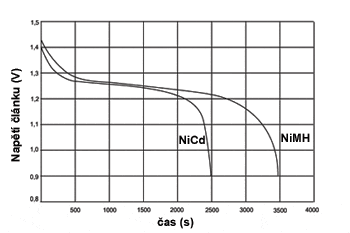 |
| Discharge characteristics NiCd and NiMH batteries. |
- One of the greatest limitations of NiMH is higher internal resistance and thus less useful currents and longer charging times. NiMH manufacturing technology constantly improving, however, and therefore
WE can be expected soon that technology will gradually replace NiMH and NiCd cells in a sector where it is required maximum current consumption (cordless tools, airsoft, air modeling).
- Chargers for NiMH others are more sensitive (NiMH voltage drop after charging significantly less pronounced).
- NiMH batteries do not contain toxic cadmium and are therefore much more environmentally friendly.
- NiMH have the same dimensions larger capacity than NiCd.
- Probably the most significant difference is in the storage of NiMH batteries fully charged, preferably at 60% capacity. NiCd batteries are stored always empty, even if it is not used for days.
- NiMH suffer much greater self-discharge, therefore, excessive discharge and damage or even reversal is several times higher. Set stored for more than three months should be during this time discharged and charged back.
- NiMH batteries are much more sensitive to rapid and less tolerant of overcharging.
Conclusion
It is up to the discretion of each of us as WE worry about batteries. Who the above rules will not worry, time record decline in battery performance and will have to buy another. If you take good care of the battery and charge it correctly, so they will certainly reward long service life and performance.
AirsoftGuns.cz
Sources used for writing the article:
Ing. Jan Havlík – Návrh nabíjecí stanice pro NiCd akumulátory
Magazín Modelcentrum
L. Stehlík - Battex s.r.o.
BEL s.r.o.
A. Pastuch - Jeden malý rozdíl, aneb co bychom měli vědět o NiMH bateriích
www.mobil.cz









 AirsoftGuns s.r.o.
AirsoftGuns s.r.o.